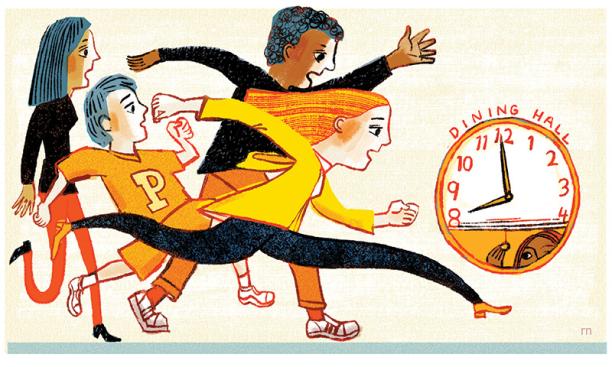
When Grace Anne McCooey ’26 finally walked out of a particularly difficult field hockey practice, it was already 7:30 p.m. One look at her watch told her she had minutes before she needed to rush up campus if she wanted to get dinner before dining halls closed. Her stomach grumbled — she needed food. Moving as fast as she could, she showered, changed, and ran out of Jadwin Gym. At 7:58 p.m, she reached Rockefeller College, with just two minutes to spare.
Varsity athletes make up about 18% of Princeton’s undergraduate population, according to the Undergraduate Admission website, and as scholars and athletes, they face many competing demands, with full schedules of training and classes and narrow timeframes to access the dining halls. McCooey and her dinnertime dash represent one end of the spectrum. On the other are athletes whose teams practice early, before dining halls open for breakfast, and don’t have time to eat between practice and class.
Alternatives do exist: “Late Meal” at Frist Campus Center opens when dining halls close, with all students given an allowance of $9.50 for lunch or dinner. However, many athletes struggle with the scarcity of healthy options — burgers, fries, and quesadillas are often the main warm foods on offer.
“My body feels strange when I eat a lot of junk food — clogged or uncomfortable. Even the healthier options [at Late Meal] are super greasy,” said Simon Xiao ’26, a libero on the men’s volleyball team.
“I’ve had to adjust to having to take my nutrition into my own hands. I need to go and spend my own money with things that work for me because the nutrients [fueling stations] provide don’t fuel my body correctly.”
— Liz Agatucci ’24
Forward, field hockey
The problem extends beyond regular meal hours into pre- and post-training nutrition. “Fueling stations” around Jadwin Gym are designed to make energy and recovery snacks easily accessible, but athletes point out that they offer sugary, processed foods and are rarely restocked, earning them the colloquial title of “starvation stations.”
“I’ve had to adjust to having to take my nutrition into my own hands,” said Liz Agatucci ’24, a forward on the field hockey team. “I need to go and spend my own money with things that work for me because the nutrients [fueling stations] provide don’t fuel my body correctly.”
Hector Martinez, the sports performance dietician on campus, said he is acutely aware of these gaps and is working to improve the nutrition of student-athletes while also providing personalized advice.
“Currently, Athletics is evaluating protocols and procedures pertaining to the fueling needs of student-athletes to enhance their experience. Student-athletes can also meet with me to discuss strategies on how to meet their energy needs amidst many competing demands, and/or certain behaviors that prevent them from fueling properly,” Martinez wrote in an email to PAW.
Martinez added that he actively works to make nutrition information more accessible to athletes to ensure that they feel equipped with the knowledge to make the best choices. Athletes receive weekly emails with nutrition information and attend teamwide information sessions led by Martinez, who notes that it’s essential these sessions don’t add stress to already busy schedules.
Many student-athletes are grateful for this personalized approach: “Hector has been so supportive and so helpful — you can tell that he really cares. Every time, I have gotten the help and support that I’ve needed,” Agatucci said.
Among the programs aimed at the specific needs of athletes is a dining plan during winter break, when training resumes but dining halls remain closed. Athletes are provided a per diem of $45 to buy food from local businesses to ease the financial burden of eating and training during this period.
Despite the challenges, many athletes who spoke with PAW are against an athlete-specific dining hall.
“Maybe in other schools an athlete dining hall makes sense, but I love eating with non-athletes — it makes me feel like I’m part of the wider school community. It’s done in the spirit of equality,” said Nicholas Lawson ’25, an épéeist on the men’s fencing team.
“I feel like in other schools, athletes live in an athlete bubble, and this way we see more people — it’s simply better,” added Julia Jongejeugd ’26, a heptathlete on the women’s track and field team.
Athletes who spoke with PAW say the five dining halls currently open do provide necessary nutrition and variety. They voiced a desire not for a different dining system, but for an improved one that more intentionally accommodates the needs of athletes on campus — whether that means having easy and quick access to nutritious food before and after training, or simply more time to get to a dining hall.
Issa Mudashiru ’25, a defender on the men’s soccer team, advocated for extending Late Meal until midnight, while McCooey, a forward on the field hockey team, would like to see a fresh approach to supplementary nutrition.
“I would give every team a separate fueling station, tailored to what each team needs, male and female athletes,” McCooey said. “I would also do more than just bars — fruit, bagels, real foods, not super processed foods that make you feel awful.”

